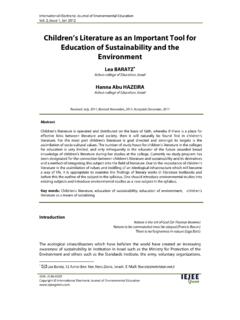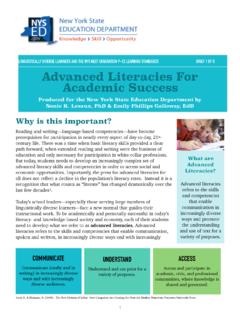Transcription of Creating effective student engagement in online courses ...
1 Journal of the Scholarship of Teaching and Learning, Vol. 10, No. 2, June 2010, pp. 1 13. Creating effective student engagement in online courses : What do students find engaging? Marcia D. Dixson1 Abstract: While this paper set out to discover what activities and/or interaction channels might be expected to lead to more highly engaged students , what it found was a bit different. After first Creating a scale to measure online student engagement , and then surveying 186 students from six campuses in the Midwest, the results indicate that there is no particular activity that will automatically help students to be more engaged in online classes.
2 However, the results also suggest that multiple communication channels may be related to higher engagement and that student - student and instructor- student communication are clearly strongly correlated with higher student engagement with the course , in general. Thus, advice for online instructors is still to use active learning but to be sure to incorporate meaningful and multiple ways of interacting with students and encouraging/requiring students to interact with each other. Keywords: active learning, online teaching, social presence, student engagement There are two primary reasons for studying student engagement in online courses .
3 The first is that online courses are here to stay and growing so we need to do them well. The growth of online courses continues to rise dramatically. In fall, 2005 million university higher education students in the United were taking at least one online course , up from million the previous year (Allen and Seamna, 2006). The second reason is that one of the primary components of effective online teaching (or any other teaching, for that matter) is student engagement . Therefore, it is imperative that we learn what engages students in order to offer effective online learning environments.
4 I. effective online Instruction. Research into effective online instruction offers three conclusions: 1) online instruction can be as effective as traditional instruction; 2) to do so, online courses need cooperative/collaborative (active) learning and 3) strong instructor presence. A. As effective as traditional. Several researchers have found that online students can and often do outperform traditional students (Maki and Maki, 2007). Maki and Maki (2007) found that students were often required to do more in online courses than in traditional courses . They also concluded that, to be effective , online instruction required strong methodology and opportunities for students to interact with each other and the instructor.
5 Other researchers have echoed these findings, discovering that 1 Department of Communication, Indiana University Purdue University Fort Wayne, 2101 E. Coliseum, Fort Wayne, IN 46805 Dixson, M. D. Journal of the Scholarship of Teaching and Learning, Vol. 10, No. 2, June 2010. ~josotl 2 online students report learning more and spending more time on task (Robertson, Grant, and Jackson, 2005), being more engaged than traditional students according to the NSSE (National Survey of student engagement ) averages (Robinson and Hullinger, 2008), having higher achievement and performing better (Conolly et al.)
6 , 2007; Lim, et al., 2008). Like Maki and Maki, Zhao, Lui, Lai, and Tan (2005) reported that students do better with instructor interaction and communication. The potential for online courses to be as or more effective than traditional courses is there. What does it take to accomplish this? Other research indicates the potential may be realized with active learning strategies. B. Cooperation/collaboration. One of the recurrent themes in the literature is the effectiveness of using collaborative activities, group discussions, and other forms of student - student interaction. Gayton and McEwen (2007) found rapport and collaboration between students , thought provoking questions, and dynamic interaction among the top instructional processes identified by instructors and students .
7 They believe an interactive and cohesive environment that includes group work, regular assignments, and solid feedback are needed for success. levy (2008) found collaborative activities along with other interactions such as reading students posts were valued by students . Graham et al. (2001) states that a well designed discussion facilitates meaningful cooperation (p. 2). Collaborative/interactive activities seem to be a necessary component to effective online instruction. A few articles state that a variety of instructional methods are needed for effective online instruction (Chickering and Ehrmann, 1996; Gaytan and McEwen, 2007).
8 However, only one researcher mentions specific strategies such as moving away from recorded lectures, readings, homework and tests toward more interactive and active learning environments like virtual teams, games, case studies etc. (Johnson and Aragon, 2003). Active learning is also touted as a way to engage students in the online environment (Chickering and Ehrmann, 1996). However, active learning, like collaboration, is a broad term and can encompass everything from students being given the opportunity to talk about what they are learning to students using simulation software and designing radio antenna (Chickering and Ehrmann, 1996).
9 One area that deserves investigation is the specific types of active learning or collaboration in online courses that students find engaging. Thus, the first two research questions are posited: RQ1: What types of active learning in online courses do students report as engaging? RQ2: Is there a difference in the active learning activities reported by high engagement versus low engagement students ? C. Instructor presence. The third conclusion from the literature is that instructors need to be actively involved in the learning of their students (Gayton and McEwen, 2007; Young, 2006). Instructors should be minimally active in discussions (Dennen, et al.)
10 , 2007; levy , 2008; Shea, Li, and Pickett, 2006; Young, 2006) and use email appropriately (Dennen, et al, 2007; Gayton and McEwen, 2007, levy , 2008). Dennen et al. (2007) did find, however, that too much instructor participation in discussion boards etc. can actually decrease student participation. Social presence of instructors and students is a concern of online researchers. Social presence is the phenomenon that helps translate virtual activities into impressions of real Dixson, M. D. Journal of the Scholarship of Teaching and Learning, Vol. 10, No. 2, June 2010. ~josotl 3 people. Kehrwald (2008) defines social presence as performative, that is, it was demonstrated by visible activity; posting messages, responding to others, and participating in the activities of the groups (pp.
















